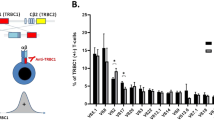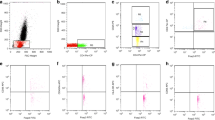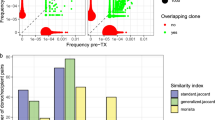Abstract
(Very) severe acquired aplastic anemia ((v)SAA) and myelodysplastic syndrome (MDS) are rare diseases in childhood. (V)SAA is a bone marrow (BM) failure syndrome characterized by immune-mediated destruction of hematopoietic progenitors. MDS is a malignant clonal stem cell disorder, of which the hypoplastic variant is, in case of absence of a cytogenetic clone, difficult to separate from (v)SAA. Recently, studies provided a molecular signature of autoimmunity in adult (v)SAA, by showing oligoclonality based on the length of the TCR Vβ CDR3 region. We investigated retrospectively the frequency and the discriminative value of TCR Vβ CDR3 oligoclonality in pediatric (v)SAA and MDS patients. Peripheral blood (PB) and/or BM mononuclear cell samples of pediatric patients with (v)SAA (n=38), refractory cytopenia (MDS-RC) (n=28) and 18 controls were analysed via TCR Vβ heteroduplex PCR analysis of extracted RNA. A skewed TCR Vβ CDR3 repertoire was found in 21/38 (v)SAA and in 17/28 RC patients in contrast to 2/18 in the control group. These data suggest an overlapping group of RC and SAA patients that may share a common immune-mediated pathogenesis. Prospective studies are required to establish the clinical value of TCR Vβ CDR3 repertoire analysis to predict the clinical response in these patients.
This is a preview of subscription content, access via your institution
Access options
Subscribe to this journal
Receive 12 print issues and online access
$259.00 per year
only $21.58 per issue
Buy this article
- Purchase on Springer Link
- Instant access to full article PDF
Prices may be subject to local taxes which are calculated during checkout


Similar content being viewed by others
References
Rosenfeld S, Follmann D, Nunez O, Young NS . Antithymocyte globulin and cyclosporine for severe aplastic anemia: association between hematologic response and long-term outcome. JAMA 2003; 289: 1130–1135.
Young NS, Maciejewski J . The pathophysiology of acquired aplastic anemia. N Engl J Med 1997; 336: 1365–1372.
Brodsky R . Acquired severe aplastic anemia in children: is there a standard of care? Pediatr Blood Cancer 2004; 43: 711–712.
Fuhrer M, Rampf U, Baumann I, Faldum A, Niemeyer C, Janka-Schaub G et al. Immunosuppressive therapy for aplastic anemia in children: a more severe disease predicts better survival. Blood 2005; 106: 2102–2104.
Marsh JC . Results of immunosuppression in aplastic anaemia. Acta Haematol 2000; 103: 26–32.
Bacigalupo A, Bruno B, Saracco P, Di Bona E, Locasciulli A, Locatelli F et al. Antilymphocyte globulin, cyclosporine, prednisolone, and granulocyte colony-stimulating factor for severe aplastic anemia: an update of the GITMO/EBMT study on 100 patients. European Group for Blood and Marrow Transplantation (EBMT) Working Party on Severe Aplastic Anemia and the Gruppo Italiano Trapianti di Midolio Osseo (GITMO). Blood 2000; 95: 1931–1934.
Fuhrer M, Burdach S, Ebell W, Gadner H, Haas R, Harbott J et al. Relapse and clonal disease in children with aplastic anemia (AA) after immunosuppressive therapy (IST): the SAA 94 experience. German/Austrian Pediatric Aplastic Anemia Working Group. Klin Padiatr 1998; 210: 173–179.
Kojima S, Horibe K, Inaba J, Yoshimi A, Takahashi Y, Kudo K et al. Long-term outcome of acquired aplastic anaemia in children: comparison between immunosuppressive therapy and bone marrow transplantation. Br J Haematol 2000; 111: 321–328.
Kardos G, Baumann I, Passmore SJ, Locatelli F, Hasle H, Schultz KR et al. Refractory anemia in childhood: a retrospective analysis of 67 patients with particular reference to monosomy 7. Blood 2003; 102: 1997–2003.
Hasle H, Niemeyer CM, Chessells JM, Baumann I, Bennett JM, Kerndrup G et al. A pediatric approach to the WHO classification of myelodysplastic and myeloproliferative diseases. Leukemia 2003; 17: 277–282.
Kook H, Risitano AM, Zeng W, Wlodarski M, Lottemann C, Nakamura R et al. Changes in T-cell receptor VB repertoire in aplastic anemia: effects of different immunosuppressive regimens. Blood 2002; 99: 3668–3675.
Risitano AM, Kook H, Zeng W, Chen G, Young NS, Maciejewski JP . Oligoclonal and polyclonal CD4 and CD8 lymphocytes in aplastic anemia and paroxysmal nocturnal hemoglobinuria measured by V beta CDR3 spectratyping and flow cytometry. Blood 2002; 100: 178–183.
Risitano AM, Maciejewski JP, Green S, Plasilova M, Zeng W, Young NS . In-vivo dominant immune responses in aplastic anaemia: molecular tracking of putatively pathogenetic T-cell clones by TCR beta-CDR3 sequencing. Lancet 2004; 364: 355–364.
Wlodarski MW, Gondek LP, Nearman ZP, Plasilova M, Kalaycio M, Maciejewski JP . Molecular strategies for detection and quantitation of clonal cytotoxic T cell responses in aplastic anemia and myelodysplastic syndrome. Blood 2006; 108: 2632–2641.
Camitta BM, Thomas ED, Nathan DG, Santos G, Gordon-Smith EC, Gale RP et al. Severe aplastic anemia: a prospective study of the effect of early marrow transplantation on acute mortality. Blood 1976; 48: 63–70.
Cantu Rajnoldi A, Fenu S, Kerndrup G, van Wering ER, Niemeyer CM, Baumann I . Evaluation of dysplastic features in myelodysplastic syndromes: experience from the morphology group of the European Working Group of MDS in Childhood (EWOG-MDS). Ann Hematol 2005; 84: 429–433.
Langerak AW, Szczepanski T, van der Burg M, Wolvers-Tettero IL, van Dongen JJ . Heteroduplex PCR analysis of rearranged T cell receptor genes for clonality assessment in suspect T cell proliferations. Leukemia 1997; 11: 2192–2199.
Langerak AW, van Den Beemd R, Wolvers-Tettero IL, Boor PP, van Lochem EG, Hooijkaas H et al. Molecular and flow cytometric analysis of the Vbeta repertoire for clonality assessment in mature TCRalphabeta T-cell proliferations. Blood 2001; 98: 165–173.
Epperson DE, Nakamura R, Saunthararajah Y, Melenhorst J, Barrett AJ . Oligoclonal T cell expansion in myelodysplastic syndrome: evidence for an autoimmune process. Leuk Res 2001; 25: 1075–1083.
Plasilova M, Risitano A, Maciejewski JP . Application of the molecular analysis of the T-cell receptor repertoire in the study of immune-mediated hematologic diseases. Hematology 2003; 8: 173–181.
Sloand EM, Mainwaring L, Fuhrer M, Ramkissoon S, Risitano AM, Keyvanafar K et al. Preferential suppression of trisomy 8 compared with normal hematopoietic cell growth by autologous lymphocytes in patients with trisomy 8 myelodysplastic syndrome. Blood 2005; 106: 841–851.
Asano Y, Maeda M, Uchida N, Yokoyama T, Osaki K, Shimoda K et al. Immunosuppressive therapy for patients with refractory anemia. Ann Hematol 2001; 80: 634–638.
Biesma DH, van den Tweel JG, Verdonck LF . Immunosuppressive therapy for hypoplastic myelodysplastic syndrome. Cancer 1997; 79: 1548–1551.
Jonasova A, Neuwirtova R, Cermak J, Vozobulova V, Mocikova K, Siskova M et al. Cyclosporin A therapy in hypoplastic MDS patients and certain refractory anaemias without hypoplastic bone marrow. Br J Haematol 1998; 100: 304–309.
Molldrem JJ, Leifer E, Bahceci E, Saunthararajah Y, Rivera M, Dunbar C et al. Antithymocyte globulin for treatment of the bone marrow failure associated with myelodysplastic syndromes. Ann Intern Med 2002; 137: 156–163.
Stadler M, Germing U, Kliche KO, Josten KM, Kuse R, Hofmann WK et al. A prospective, randomised, phase II study of horse antithymocyte globulin vs rabbit antithymocyte globulin as immune-modulating therapy in patients with low-risk myelodysplastic syndromes. Leukemia 2004; 18: 460–465.
Tamayose K, Sugimoto K, Ando M, Oshimi K . Disappearance of chromosomal abnormalities and recovery of hematopoiesis after immunosuppressive therapy for hypoplastic refractory anemia with excess of blasts. Blood 2001; 97: 2524.
Yamada T, Tsurumi H, Kasahara S, Hara T, Sawada M, Moriwaki H . Immunosuppressive therapy for myelodysplastic syndrome: efficacy of methylprednisolone pulse therapy with or without cyclosporin A. J Cancer Res Clin Oncol 2003; 129: 485–491.
Yoshimi A, Baumann I, Fuhrer M, Bergstrasser E, Gobel U, Sykora KW et al. Immunosuppressive therapy with anti-thymocyte globulin and cyclosporine A in selected children with hypoplastic refractory cytopenia. Haematologica 2007; 92: 397–400.
Acknowledgements
We thank E Velleuer for collecting a subset of the data for this study. This project was supported by a grant from the Foundation KiKa, Amstelveen, The Netherlands.
Author information
Authors and Affiliations
Corresponding author
Rights and permissions
About this article
Cite this article
de Vries, A., Langerak, A., Verhaaf, B. et al. T-cell receptor Vβ CDR3 oligoclonality frequently occurs in childhood refractory cytopenia (MDS-RC) and severe aplastic anemia. Leukemia 22, 1170–1174 (2008). https://doi.org/10.1038/leu.2008.23
Received:
Revised:
Accepted:
Published:
Issue Date:
DOI: https://doi.org/10.1038/leu.2008.23
Keywords
This article is cited by
-
Clonal hematopoiesis in adult pure red cell aplasia
Scientific Reports (2021)
-
Incidence and outcomes of refractory immune thrombocytopenic purpura in children: a retrospective study in a single institution
Scientific Reports (2021)
-
Multiple myeloma causes clonal T-cell immunosenescence: identification of potential novel targets for promoting tumour immunity and implications for checkpoint blockade
Leukemia (2016)
-
T-cell receptor Vβ skewing frequently occurs in refractory cytopenia of childhood and is associated with an expansion of effector cytotoxic T cells: a prospective study by EWOG-MDS
Blood Cancer Journal (2014)
-
Long-term survival in multiple myeloma is associated with a distinct immunological profile, which includes proliferative cytotoxic T-cell clones and a favourable Treg/Th17 balance
Blood Cancer Journal (2013)



